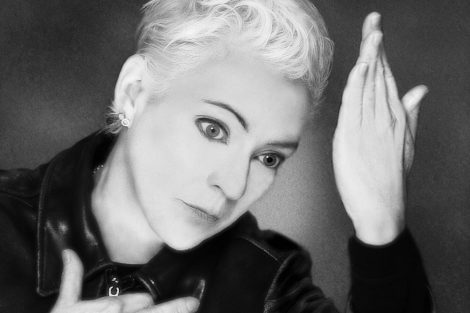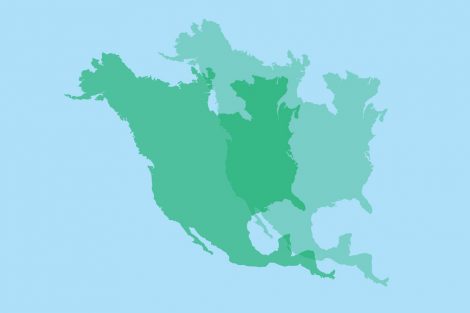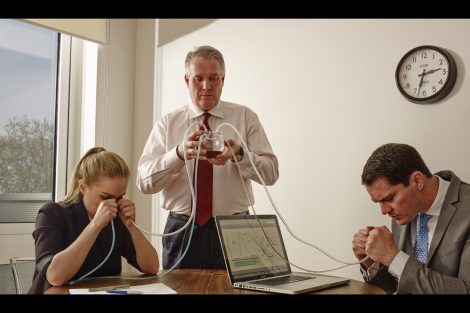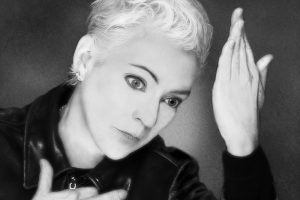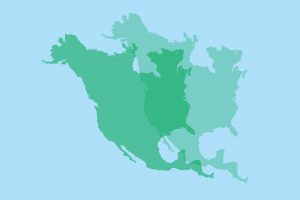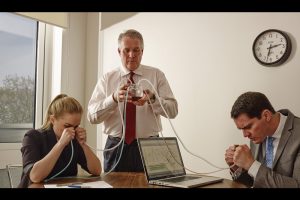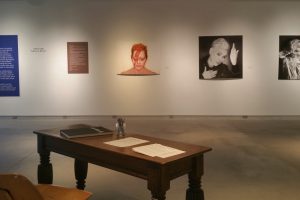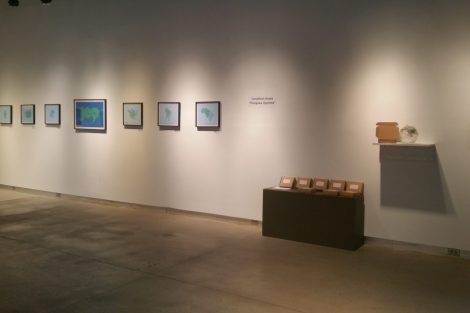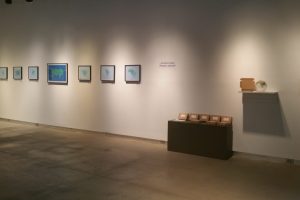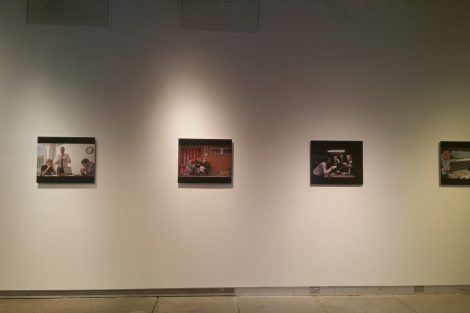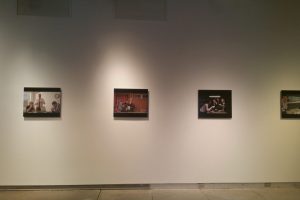Hypothetically
February 10-April 14, 2018
Hypothetically
Curator, Julia Buntaine, Director & Editor in Chief of SciArt Center & Magazine
Julia Buntaine’s curator’s talk was rescheduled to Wednesday, March 21, Williams Center 108 at 4:10 p.m., A reception will follow at the Grossman Gallery immediately following the lecture
___________
Kathy High | Jonathon Keats | Raphael Kim
Collaboration between the arts and sciences is a popular notion that has evolved far beyond a buzz word. Revived by contemporary initiatives inspired by the late C.P. Snow’s lament on the gap between the two cultures of art and science, collaboration is a tangible way in which the two disciplines cannot only create a bridge of mutual understanding, but can lead to comprehensive approaches to our 21st century opportunities and problems. Artists are often the champions of the charge for cross-disciplinary work because they are free to take risks which others may deem improbable, irresponsible, or impossible.
While many successful cross-disciplinary collaborations have been created, such as Olafur Elisaon’s work to get electricity to off-the-grid countries in Little Sun and Natalie Jeremijenko’s efforts to curb the effects of the Anthropocene in pieces such as Butterfly Bridge, there are those projects which have yet to be realized and reside, perhaps forever, in the realm of the hypothetically possible.
Walking the lines of the allowable in bioethics and the possible in technology, “Hypothetically” presents artists that create work which propose experiments, initiatives, and solutions to persistent issues, from the level of the microbe to the whole of the planet.
What problems would you solve, how, and why? In the hypothetical, everything is possible, including the impossible. We invite you to think broadly and add your ideas to a notebook in the gallery.
Kathy High
Kathy High’s series “Kathy as Bowie” taps into the personal side of one of today’s most exciting scientific topics – the microbiome. Living with Crohn’s disease, much of High’s recent work relates to gut health, and her research into potential cures feeds back into her artwork. One possible cure for those with gut health diseases involves a transplant – specifically, a fecal microbial transplant – from one healthy person’s feces to another unhealthy person’s bowels. This transplant has the potential to let healthy gut flora propagate and cure unhealthy gut environments. Only beginning to gain popularity as a treatment in the United States, Kathy took matters into her own hands and decided to contact the donor of her choice – the late (then living) David Bowie. While her request went unanswered, High’s pieces reveal the personal side to this medicinal request – that is, the request to literally embody the biology of another. This work raises questions about the future of humans as biological and mechanical transplants become easier to accomplish and integrate: What percentage of our own cells need to be present in our cellular landscapes in order for our bodies to remain our own? Can we strategically incorporate microbial aspects of one another to change ourselves for the better? Can we ever literally become more like someone else – like David Bowie?
Kathy High is an interdisciplinary artist working in the areas of technology, science and art. She works with animals and living systems, considering the social, political and ethical dilemmas surrounding medicine/bio-science, biotechnology, and interspecies collaborations. High is Professor in the Department of the Arts, at Rensselaer Polytechnic Institute, Troy, NY.
Read more about Kathy High in this link to “Gut Instinct.”
Jonathon Keats
Jonathon Keats likes to tackle issues big to small – he reverses biomimicry to provide sex toys for plants, and sells ingots of lead as a means to slow aging via general relativity. In Pangea Optima, Keats provides a solution to counter climate change by bringing us all – that is, our Earth’s continents – a bit closer together. Pangea Optima proposes a migrating and merging of all continents into a super-continent, using geoengineering principles to solve the issue at the core of climate change: our country-centric view of the world. How can we come together to solve a complex global issue when our motives, biases, and politics are defined by a country-based outlook? The physical uniting of nations, Pangea Optima closes the conceptual, political, and geographical gulfs between continents and countries, forcing our common ground (literally), rather than our differences, to define us. To represent this idea, Keats shows us the world as a jigsaw puzzle, and how our continents could move together to optimize continental connection, Antarctica included. Pangea Optima’s proposal drastically changes the face of our planet – from continents entering entirely new climate zones to new-shared borders testing historically tenuous relationships. Through this project we are left to wonder if the only way to save our planet is to change it entirely, and with Keats’ accompanying “Pangea Kit,” you can design your own solution.
Jonathon Keats is a conceptual artist and experimental philosopher in San Francisco.
See more about his 2015 exhibition, Panagaea Optima, at the Modernism Gallery website, and additional information here
Raphael Kim
Raphael Kim’s “Microbial Money” casts microorganisms in the role of oracle to better predict the behavior of the economy. With a background in pharmaceutical research and biotechnology, Kim often imagines how microorganisms could be designed to explore implications of human economic life – from serving as a new form of currency to helping to bring new life to obsolete currencies like the Drachma. In “Microbial Money” Kim pairs the unpredictable nature of biology with the fluctuating nature of the finance industry, proposing that we use nature, on the micro-level, to guide our decisions while navigating the macro-state of the economy. Natural patterns, events, and phenomenon have played the role of fortuneteller in cultures throughout time, and “Microbial Money” is not without scientific precedent, either; in 2015 scientists from The University of Austin, Texas, published a paper on analogous behaviors in advantageous stock trading and bacterial interaction. Through his photographs Kim shows us financiers working with biohacker-suppliers to get the edge on the market – from praying to the micro-oracle, making backseat bacterial deals, analyzing the stock market via pipette, and conducting alleyway experiments with propane, Kim’s alternative world is full of drama and intrigue. Letterboxed like a movie frame, Kim’s photographs put us in the moment of the micro-action but leaves out the specifics, letting our imagination wander in this fictional but recognizable reality.
Raphael Kim is a London–based artist embedded in the biohacker movement. Currently earning his PhD in Media Arts and Technology at Queen Mary University, Kim is trained in biotechnoogy and has a professional background in pharmaceutical research.
Additional information about Raphael Kim’s work can be found at this article in the December 2016 issue of Sci-Art
